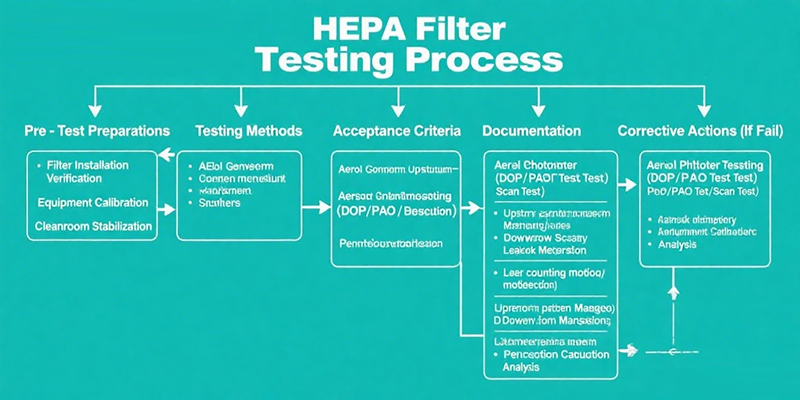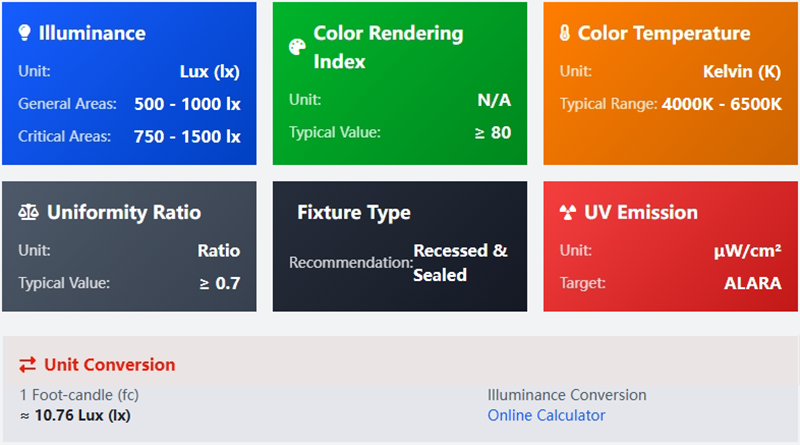Cleanroom Testing is critical and covers HEPA filter integrity, lighting, vibration, sound, airborne particle counts, and airflow measurements. These tests play an important role in validating and maintaining cleanroom performance, ensuring compliance with industry standards, and protecting sensitive processes.
HEPA Integrity Testing
HEPA (High-Efficiency Particulate Air) filters are the heart of any cleanroom's air filtration system. HEPA integrity testing verifies that these filters are functioning correctly and free from leaks, ensuring they effectively remove airborne particles. Common testing methods include:
- DOP/PAO Testing: Introducing a challenge aerosol (typically Dioctyl Phthalate or Polyalphaolefin) upstream of the filter and measuring the penetration downstream using a photometer. A low penetration indicates a high-integrity filter. This method adheres to standards like IEST-RP-CC001.6.
- Particle Counting: Using a particle counter to measure particle concentrations upstream and downstream of the filter.
Acceptance criteria typically require a penetration of less than 0.01% for each filter.

Lighting Testing
Adequate lighting is essential for personnel to perform their tasks effectively and safely. Lighting testing ensures that the cleanroom meets specified illumination levels. Key considerations include:
- Illuminance Measurement: Measuring the light intensity (illuminance) at various points within the cleanroom using a calibrated light meter.
- Uniformity Assessment: Evaluating the uniformity of lighting across the work area to prevent glare or shadows.
Lighting levels are typically specified in lux (lx) or foot-candles (fc) and vary based on the tasks performed in the cleanroom. Standards like the IESNA Lighting Handbook provide detailed guidelines for industry-specific requirements.

Vibration Testing
In sensitive applications such as Semiconductor manufacturing and nanotechnology, vibration testing is crucial to minimize the impact of vibrations on delicate processes and equipment. Testing methodologies include:
- Accelerometer Measurements: Using accelerometers to quantify vibration levels at strategic locations within the cleanroom.
- Frequency Analysis: Analyzing the frequency spectrum of vibrations to identify potential sources of disturbance (e.g., mechanical equipment or external infrastructure).
Vibration criteria are often defined by VC (Vibration Criterion) curves, which specify allowable limits for vibration velocity or acceleration based on application sensitivity.
Sound Testing
Excessive noise levels can compromise worker comfort and productivity. Sound testing measures the sound pressure levels within the cleanroom to ensure compliance with occupational health standards. Key testing approaches include:
- Sound Level Meter Measurements: Using calibrated instruments to measure sound pressure levels (SPL) at multiple locations.
- Frequency Analysis: Assessing the frequency content of noise to identify dominant sources (e.g., HVAC systems or process equipment).
Sound levels are quantified in decibels (dB), with permissible exposure limits defined by OSHA guidelines to protect worker hearing health.
Continuous Particle Testing
Maintaining low particle concentrations is the core objective of cleanroom operations. Continuous particle testing involves real-time monitoring to detect deviations from specified cleanliness limits. Key components include:
- Particle Counter Placement: Strategic positioning of counters at critical process areas and airflow pathways.
- Data Logging & Analysis : Automated systems for continuous data collection and trend analysis to identify contamination sources.
- Alarm Systems: Real-time alerts for particle count exceedances, enabling immediate corrective action.
Data is evaluated against ISO 14644-1 CleanRoom Classification limits to ensure ongoing compliance with international standards.
Airflow Testing
Proper airflow is essential for removing airborne particles and maintaining a uniform clean environment. Airflow testing verifies that design specifications for velocity, pattern, and air change rates are met. Key methodologies include:
- air velocity Measurements: Using anemometers or pitot tubes to measure velocity at defined points in the cleanroom.
- Airflow Pattern Visualization: Smoke generators or tracer gases to visualize airflow dynamics and identify stagnation/turbulence zones.
- Air Change Rate (ACR) Calculation: Determining the number of air changes per hour based on airflow volume and CleanRoom dimensions.
| Testing Parameter | Testing Method | Acceptance Criteria | Relevant Standards |
|---|---|---|---|
| HEPA Filter Integrity | DOP/PAO Testing, Particle Counting | Penetration < 0.01% | IEST-RP-CC001.6, ISO 14644-3 |
| Lighting | Illuminance Measurement | Specified lux or foot-candle levels | IESNA Lighting Handbook |
| Vibration | Accelerometer Measurements | Vibration velocity/acceleration limits | VC Curves |
| Sound | Sound Level Meter Measurements | Specified decibel (dB) limits | OSHA Guidelines |
| Particle Counts | Airborne Particle Counting | Meets iso 14644-1 classification limits | ISO 14644-1 |
| Airflow | Air Velocity Measurements, Airflow Visualization | Meets design specifications for velocity and patterns | ISO 14644-3 |
Cleanroom testing is an ongoing and essential process to validate and maintain the integrity of controlled environments. By implementing a comprehensive testing program that includes HEPA filter integrity, lighting, vibration, sound, particle counts, and airflow measurements, organizations can ensure their cleanrooms consistently meet specified standards and provide a safe and effective environment for critical processes.
 +86 18186671616
+86 18186671616 Jason@cleanroomequips.com
Jason@cleanroomequips.com
 MENU
MENU



